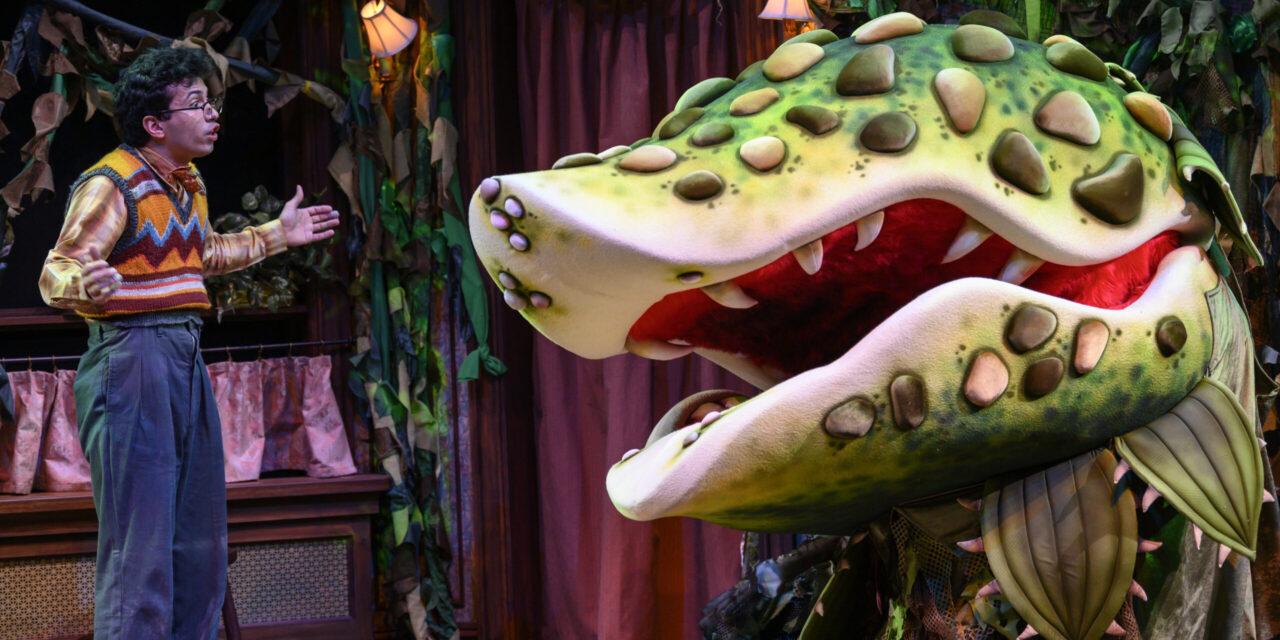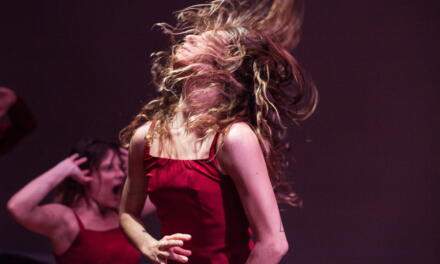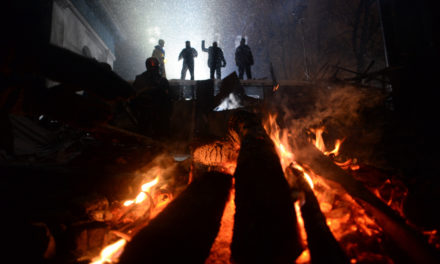There’s no way Artistic Director Marya Sea Kaminski could possibly have predicted that the impeachment trial would coincide with the Pittsburgh Public Theater run of Little Shop of Horrors. But holey moley! I can’t think of a more apropos commentary on the really big shop of horrors that is the GOP-controlled Senate than this horror-comedy rock musical about a hapless schmuck who nurtures and accommodates an evil, carnivorous plant until it becomes too powerful to contain.
Dear Reader, I know you’re a smart cookie so I won’t belabor the point and connect the dots further; besides, don’t you just want to bury your head in the sand right about now and pretend that the real-life monster just a few hours down the interstate hasn’t already grown too big to destroy? Well, luckily for all of us, Kaminski’s production of Little Shop of Horrors is so eye-poppingly gorgeous and beautifully crafted that you might – just might – be able to suspend your dread and anxiety for a couple of hours and forget that the show presents a near-perfect allegory for our present-day nightmare.
The musical tells the story of Seymour (Philippe Arroyo), who helps save the dying floral shop he works at when he discovers an unusual plant that draws in curious customers. He names the plant Audrey II after his co-worker Audrey (Lauren Marcus), on whom he has a secret crush; she, however, is in an abusive relationship with Orin (Patrick Cannon), a sadistic dentist. Seymour quickly discovers that his plant is not only carnivorous, but also that it will only eat human flesh; the Mephistopheles-like Audrey II (voiced by Monteze Freeland and animated by J. Alex Noble) uses promises of fortune, fame, and power to lead Seymour down a slippery-slope of moral compromises and rationalizations that ends with the destruction of everything he holds dear (wait, did I mention that this is a near-perfect allegory for the death of our democracy?)
Tragic as the plot is, the whole is delivered with a camp-cartoon aesthetic. Tim Mackabee’s scenic design is dominated by the exterior of a building with rows of windows that pop and bop in vibrant technicolor to the beat of the music (lighting design by Robert J. Aguilar). The building also serves as a projection surface for Bryce Cutler’s ingenious media design, which at some times has the surface crawling and writhing with images, and at others provides atmospheric effects like lightning and rain. Set, lights, and projection work in animated concert to ensure that the world of the play – like the monstrous plant it brings to life – feels alive and in motion; indeed, at times it feels as if the set itself is dancing to the energetic music along with the characters on stage (the excellent orchestra is conducted by Catie Brown; music direction by John McDaniel). In their riot of pattern and color, Susan Tsu’s detail-perfect costumes match the vivid rhythm of the scenery, lights, and media, while at the same time offering witty commentary on the characters and nudging them towards caricature. Kaminski takes full advantage of this team’s spectacular design with her energetic direction of the show, keeping the stage in motion from number to number with impeccable timing and a keen instinct for visual and physical humor.
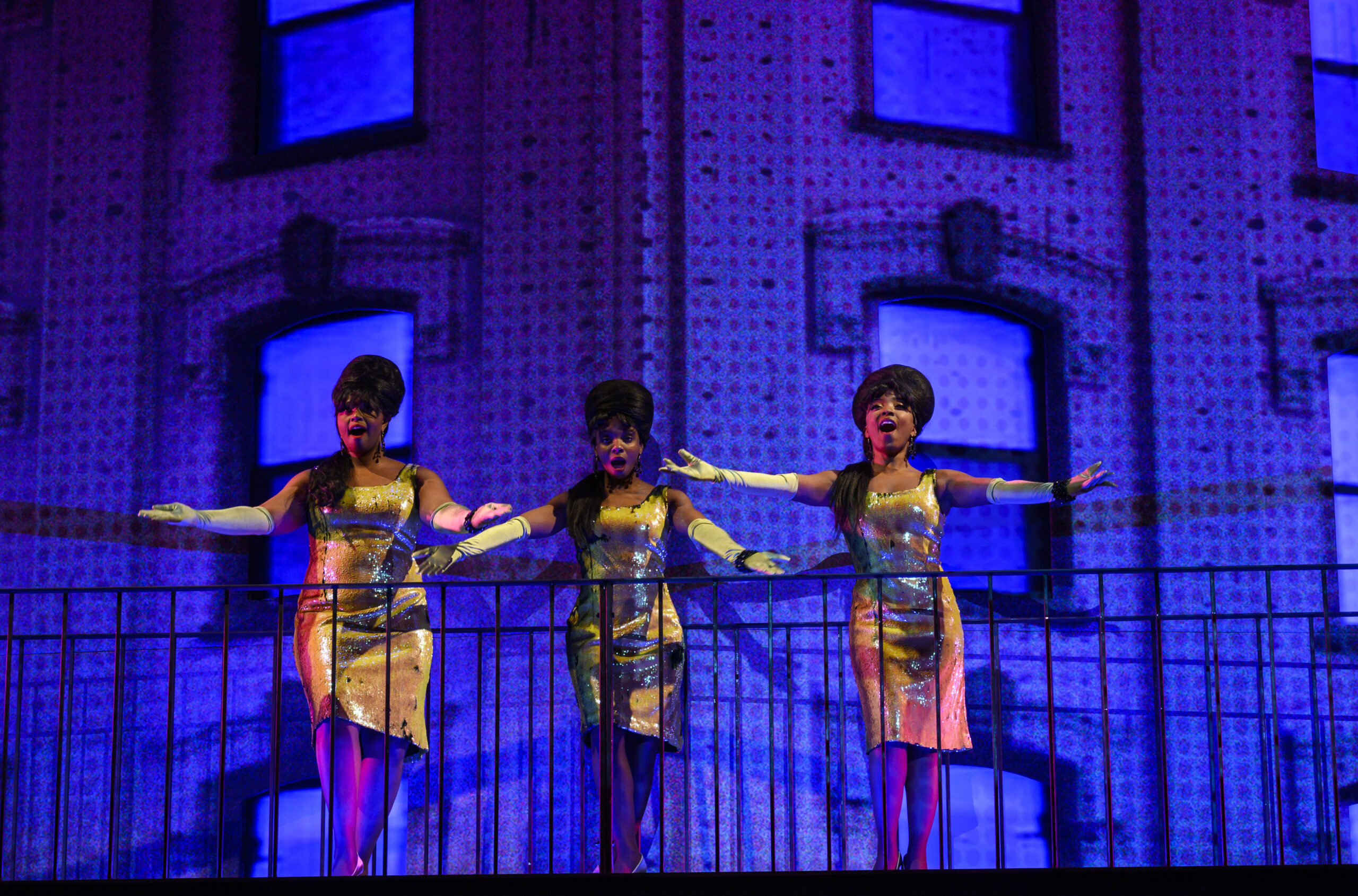
L to R: Melessie Clark, Abigail Stephenson and Tavia Riveé; photo by Michael Henninger, courtesy Pittsburgh Public Theater.
The performances in this production are equally spectacular. Setting the tone for the show from the very top is a high-energy, big-attitude trio of street-smart girls named Ronnette (Melessie Clark), Chiffon (Abigail Stephenson), and Crystal (Tavia Riveé); serving as a kind of brassy Greek chorus to the action, they channel the Motown girl groups that their names suggest with gorgeous tight harmonies. Marcus brings a Betty Boop-esque quality to her portrayal of Audrey that gives the character a nice quality of daffy sweetness, and Marc Moritz, as the floral shop owner Mr. Mushnik, is a suitably kvetching old Jew (the score itself contains a number of musical jokes; among them the klezmer send-up “Mushnik and Son” that features Moritz in a witty moment of davening). Freeland’s voice work as the bloodthirsty plant is stunning, particularly when you consider that he coordinates his performance with puppeteer Noble from an isolated room in the theater’s basement. But the standout performances in this production are Arroyo as Seymour and Cannon as Orin. Both actors bring an astonishing and delightful physicality to their roles, embodying the emotional extremes of their characters with a mixture of precision and abandon. Their total investment in the physicalization of their characters has a paradoxical effect, simultaneously enhancing the cartoonish tone of the show and adding dimension and depth to their individual characters. The scene in which Seymour visits Orin at his dental practice is a masterpiece of physical comedy that proves the rule about how high the stakes need to be for comedy to work; I also won’t soon forget Arroyo’s unbridled embodiment of Seymour’s indecision in the temptation number “The Meek Shall Inherit.”
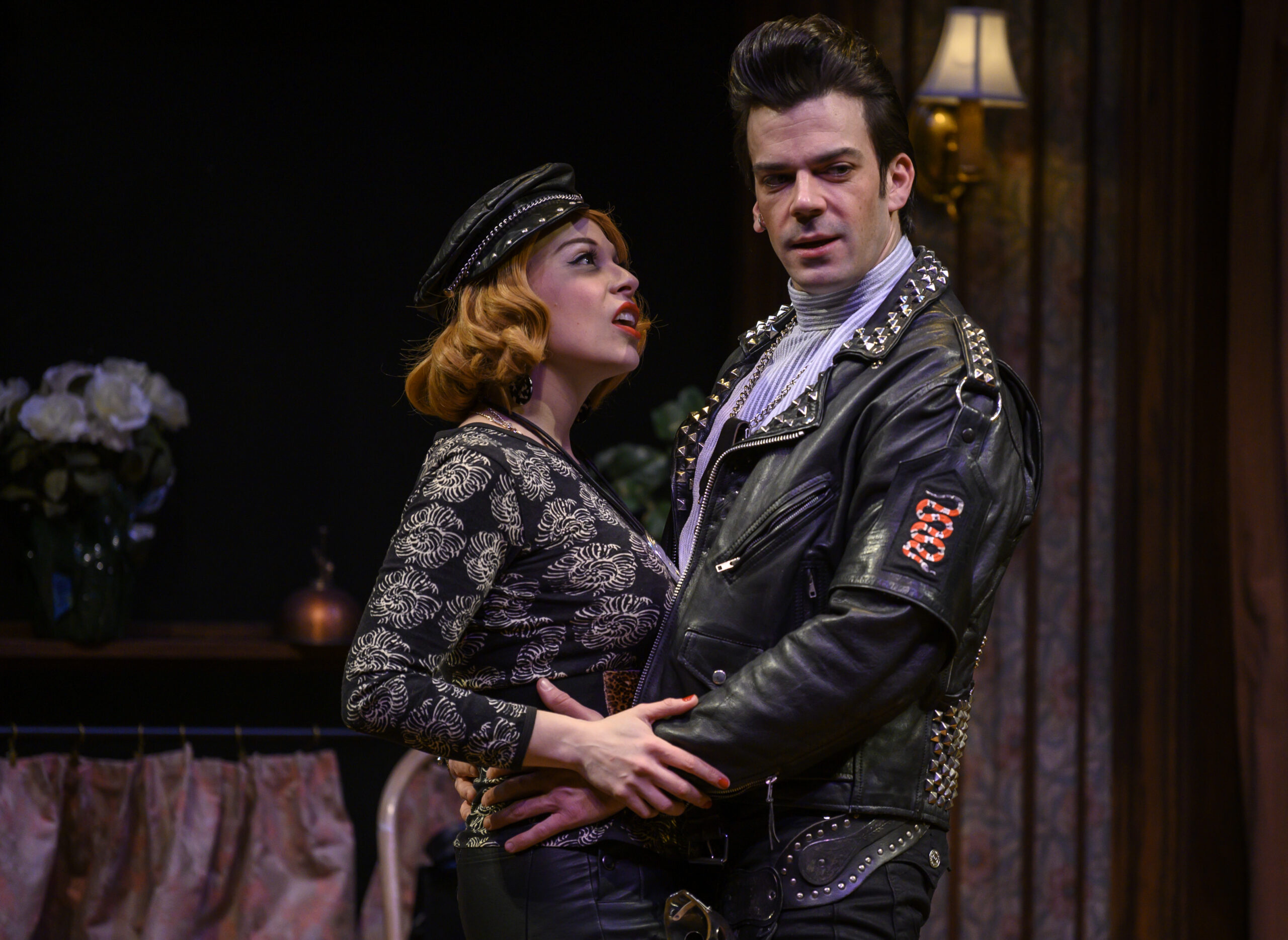
That scene, in fact, is where the mostly comic Little Shop delivers its serious insight into the psychology of accommodation. Seymour knows he has a diabolical monster on his hands, but it’s a monster that will help him achieve his goals, and his ambition causes him to lose sight of his principles and abandon his moral compass. He only realizes too late that he is just as dispensable as the rest of Audrey II’s victims. Sound familiar? There’s really only one solution, but I fear that – as in the play – in real life the advice comes far too late: “Don’t feed the plant!”
This article was originally posted in The Pittsburgh Tatler on 2 February 2020, and has been reposted with permission.
This post was written by the author in their personal capacity.The opinions expressed in this article are the author’s own and do not reflect the view of The Theatre Times, their staff or collaborators.
This post was written by Wendy Arons.
The views expressed here belong to the author and do not necessarily reflect our views and opinions.

